One of the most common questions we get on the Facebook page goes something like this:
I’m getting ready to deploy soon. What should I pack in my aid bag?
The answer is, as usual in medicine, “it depends”. There are many factors which play into what you carry in your aid bag. Here are four little philosophy lessons that will help you the next time you need to pack for a mission.
1. Know Your Environment
We are fighting in a complex world full of the unknown, the unknowable, and the ever changing. Our enemies are capable and adaptive. Enemy tactics, techniques, and procedures (TTPs) often change faster than we can adapt, and should constantly be reevaluated. Wound patterns will inform changes in supplies and plans. Medics should be concerned with what the enemy is doing right now no matter how recently they have been in theater or how long they have been a medic. Using threat-based planning and knowing the evolving wound patterns will provide medics with the information needed to organize their aid kit more effectively.
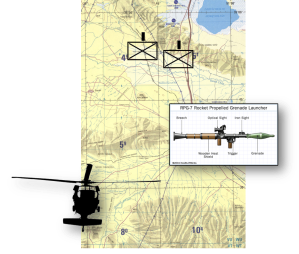 Historical wounding patterns seen in previous wars are still seen on today’s battlefields. Even in unconventional warfare, the primary method of taking a person’s life is making lots of holes in them. The gun shot and fragmentation wounds of earlier wars, and the subsequent hemorrhage are still a very serious threat. As experience and expertise have increased on both sides, our opponent’s tactics have evolved to include low- and high-tech improvised devices constructed with homemade explosives. Explosives are mounted on everything from children and dead animals to large vehicles and buildings. This creativity was later applied by adding incendiary chemicals and choking agents such as chlorine to IEDs. House-borne IEDs and other booby traps became ways to increase payoffs with relatively low cost in both money and manpower. Strategically placed IEDs in conjunction with complex ambushes now produce multiple polytrauma patients with double and triple amputations instantly.
Historical wounding patterns seen in previous wars are still seen on today’s battlefields. Even in unconventional warfare, the primary method of taking a person’s life is making lots of holes in them. The gun shot and fragmentation wounds of earlier wars, and the subsequent hemorrhage are still a very serious threat. As experience and expertise have increased on both sides, our opponent’s tactics have evolved to include low- and high-tech improvised devices constructed with homemade explosives. Explosives are mounted on everything from children and dead animals to large vehicles and buildings. This creativity was later applied by adding incendiary chemicals and choking agents such as chlorine to IEDs. House-borne IEDs and other booby traps became ways to increase payoffs with relatively low cost in both money and manpower. Strategically placed IEDs in conjunction with complex ambushes now produce multiple polytrauma patients with double and triple amputations instantly.
Threats that are seen in some theaters will not be seen in others. The types of explosively formed projectiles (EFP) used in Iraq, have not yet been seen in Afghanistan, the Philippines, or Africa; however, chlorine IEDs have been found in both Iraq and Mali.
When preparing for your mission, consider the following (METT-TC):
- What type of missions and units will be supported? Are they mounted, dismounted or waterborne? Different types of units have different missions requirements and logistical support. What works for an infantry platoon will not work for a forward observer team or an artillery battery.
- What types of opposing forces are expected? What are their capabilities? What sorts of weapons are likely to be employed? What kinds of wounds can be anticipated?
- What types of terrain will your encounter? What modes of extraction will be necessary? Urban, overwater, and mountain environments may require hoist. Open fields and roadways may require other security precautions.
- What weather will you encounter? Are there predictable weather patterns which will affect the mission? Low illumination, daily winds generating dust, seasonal fog?
- What are your guys trained to do? What other medical providers are available for the mission? Can you get another medic or a PA to come along? Have the members of your team been adequately trained in TCCC to assist?
- Where is the nearest facility with definitive care? Where are the nearest facilities with specialized care? How long will it take to get there? Will you need to transfer care to another medic or stop at an intermediate facility for stabilization?
- What do your timelines look like? How long does it typically take to transport patients from the point of injury to the nearest role II or III facility? How long could it take in the worst case scenario?
- What types of patients will be picked up? Have you identified the types of disease and non-battle injury you will encounter? What does your Medical Rules of Engagement (MEDROE) say about treating patients? Will you be treating pediatrics and the elderly? Contractors or coalition forces with underlying medical conditions?
2. Understand Your Depth of Care
Depth of care is the reasonable limit to the medical procedures you can accomplish in the given situation. Not all methods of treatment are appropriate for all phases of care. You should know what treatments are prescribed by your protocols while considering established best practices.
- Know your equipment’s capabilities and limitations. Select and carry only equipment you are familiar with. Know how to employ and maintain it.
- Be a master of your craft. Stay curious and always seek to improve your knowledge and skill. Remember that lives depend on our ability to provide the best care possible.
- Some procedures just aren’t appropriate in a given situation or environment. Even if you are qualified, don’t attempt to perform open-heart surgery in a foxhole.
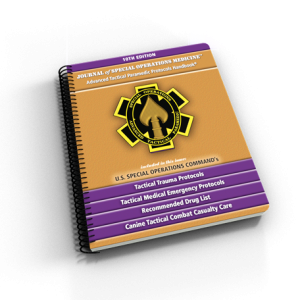 The overall approach to depth of care is not the packing of a single aid bag, but the understanding and development of your skillset and supplying it with appropriate levels of class 8 to meet the challenges in all levels of care. The equipment supplies you carry should directly match the level of training you have and the level of care anticipated.
The overall approach to depth of care is not the packing of a single aid bag, but the understanding and development of your skillset and supplying it with appropriate levels of class 8 to meet the challenges in all levels of care. The equipment supplies you carry should directly match the level of training you have and the level of care anticipated.
Two great resources are the Ranger Medic Handbook 4th Edition and the JSOM Advanced Tactical Paramedic Protocols (ATP-P) 9th Edition. Both of these books can be purchased online and are well worth the money.
3. Establish Your Depth of Supply
Depth of supply is the layered and prioritized placement of supplies and equipment to provide more complete coverage and to be more effective when it is needed the most. A depth of supply is very much like having a defense in depth on a battlefield.
Tactical Combat Casualty Care (TCCC) and the supplies that facilitate that care, starts with the individual first aid kit (IFAK) continues through the levels of care back to your medical logistics chain. Each level incrementally increases the complexity of application and amount needed to meet mission requirements and any worst-case scenarios. After the IFAK, the medic has his ruck. Then he can fall back on supplies staged in a vehicle. After that, he can rely upon cached supplies in a BAS or team house. Then finally, if MEDEVAC is available, he can use specialized equipment on the evac platform. This “Ruck, Truck, House, Plane” model is discussed in detail over on the Prolonged Field Care website.
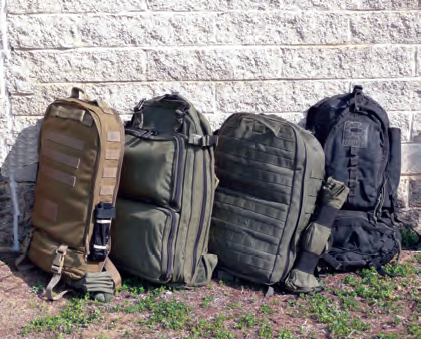
Attempts should be made to pack aid bags and stage them per priority of use; the specific types and abundance of medical supplies in the proper location will ensure success. Planning and packing in each bag should always be based on an evaluation of the worst-case scenario. The worst-case is, of course, based on mission analysis, threat assessment, and available assets. Flexibility is the overarching concept of being truly prepared for every scenario.
4. Cross-Load Your Supplies
Cross-loading medical supplies will ensure that everyone is carrying the medical gear necessary for initial life-saving intervention. It also allows the Medic to dedicate space in their own kit for more advanced items. It also creates redundancy in equipment and supplies that can cover multiple contingencies.
There is no reason for your aid bag to be bursting at the seams if your teammates’ IFAKs well supplied. You can plus-up their kit with common medical supplies such as extra gauze, small bags of saline, and other highly consumable items.
Include IFAKs in your pre-combat checks and inspections. Ensure all IFAKs are fully stocked and the contents have not expired. Keep only appropriate medical supplies in the IFAK. Keep a keen eye out for counterfeit tourniquets, outdated equipment, broken or dirty kit, and candy bars.
Other Considerations
Conserve Your Supplies
Immediate replenishment of medical supplies is not always possible. Resupply is often delayed. A lack of supply can significantly reduce your ability to care for the next set of casualties. Always expect to be hit again. Conservation of supplies should be a priority in the mind of the medic and should be exercised similarly to what has been taught for guerilla warfare. Those same habits will provide success even on today’s more developed battlefield.
These practices have been taught by good NCOs and the schoolhouse for decades and the importance of safeguarding supplies has not decreased in any way. It starts with quality training, competence and confidence in skills, and using only what is needed to treat wounds and injuries. Don’t use two rolls of gauze where one will do. Be confident in your medical training and ability to manage your patient.
Kit Your Supplies
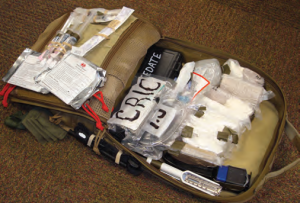 Success favors the prepared. The time put into preparing, packing, and practicing with the aid bag will pay back tenfold when it is needed the most. Likewise, packaging all the items together that will be required to do a procedure, known as “kitting” your procedures, also saves time, effort, and mental energy. To kit your procedure put all the supplies and equipment needed into a single water-resistant bag. Be sure to maintain sterility as necessary. You can use a simple Zip-Loc bag or upgrade to a vacuum sealed bag for more durability.
Success favors the prepared. The time put into preparing, packing, and practicing with the aid bag will pay back tenfold when it is needed the most. Likewise, packaging all the items together that will be required to do a procedure, known as “kitting” your procedures, also saves time, effort, and mental energy. To kit your procedure put all the supplies and equipment needed into a single water-resistant bag. Be sure to maintain sterility as necessary. You can use a simple Zip-Loc bag or upgrade to a vacuum sealed bag for more durability.
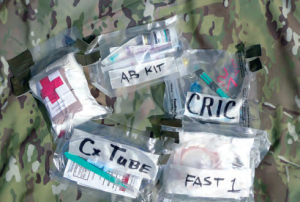 Kitting your procedures allows you to pack your aid bags in modules and will provide flexibility for any changes needed. Kits do two important things for the medic:
Kitting your procedures allows you to pack your aid bags in modules and will provide flexibility for any changes needed. Kits do two important things for the medic:
- Save time. By preparing all the equipment needed ahead of time, the medic just needs to open the kit and begin. This reduces the number of steps in a task and shaves time off the successful completion of the procedure. It also ensures that everything needed for the procedure is available so you don’t have to scramble or improvise.
- Cognitive offloading. Combining all equipment and supplies into any procedure kit will not only save time but will provide clarity under the many stressors of engagements and put you into autopilot, avoiding the need for higher cognitive thought while always providing positive progress. Having and seeing the items together will automatically prompt the Medic into the next step which increases efficiency and decreases confusion.
When building your kits, place large high-visibility labels inside them. 3″x5″ cards with large black letters can also have procedure checklists printed on the back. These “cheater cards” for each specific kit can be useful when handing any kit to a trained team member. They can immediately know what is expected without explanation.
Final Thoughts
Multi-use supplies. Medics should attempt to kit, pack, and use supplies that have multiple applications. Every item that is put into the aid bag takes up space and has weight so it is important to attempt to pack items that can be multifunctional. As you progress from your ruck to a truck or house, you will have
Practice. Conducting good training and rehearsals that will test and challenge plans and preparation, as well as reviewing after action reports, will continue to provide confidence and proper coverage. It is important that the aid bag is opened every couple of weeks to assure familiarity with its contents, especially if it hasn’t been used in some time. Aid bag drills, where the aid bag is laid out as if treating a casualty and then trying to find items in the aid bag without looking, as taught and practiced during advanced medical training, are still applicable now; no matter how good the Medic is. As always, it is important to be critical with the packing list during inspections to make sure nothing is ever forgotten, at any level of care.
“Excellence is an art won by training and habituation. We are what we repeatedly do. Excellence, then, is not an act but a habit.” – Aristotle
What tips do you have for aid bags? What do you do differently than this?
- Journal of Special Operations Medicine, Volume 8, Edition 3, Summer 2008. “Thoughts on Aid Bags, Part I”, Hetzler & Ball
- Journal of Special Operations Medicine, Volume 8, Edition 4, Fall 2008. “Thoughts on Aid Bags, Part II”, Ball & Hetzler
If you don’t have a copy of the Tactical Medical Emergency Protocols (TMEPS) you’re missing out on great info. Instructors should also consider a subscription to JSOM’s magazine. https://www.jsomonline.org/
 This site is licensed under a Creative Commons Attribution-NonCommercial 4.0 International License.
This site is licensed under a Creative Commons Attribution-NonCommercial 4.0 International License.

Great advice, especially regarding kitting and the importance of extra supplies.
One thing I would like to add is the importance of having an Aid Bag marked in a proficient manner that allows bystanders/CLS to help. Obviously you should have already trained your guys to help, but in the event it isn’t someone you haven’t trained, your aid bag should be marked generically enough so that anyone can help assist you with getting supplies from it.
Too often have I inspected aid bags to find medics that have literally labeled the outside of an aid bag pouch with every single content in fine sharpie. While this may initially seem like a good idea, it is also a tell that the medic probably doesn’t use that aid bag too often. Or (fatally) may assume that a bystander even knows what X piece of class VIII is called by nomenclature.
I would advise, depending on your mission and who you are operating with of course, that your aid bag be labeled as generally as possible. I have mine labeled with “M-A-R-C-H-E” on each pouch, with a big fat permanent marker on OD green tape, along with other “advanced” pouches that are labeled PFC (Prolonged Field Care), V/S (Vital Signs) and so on.
This allows me to efficiently direct any bystanders in the following manner:
“PVT Snuffy, grab the blanket from the ‘H’ pouch!”.
Instead of:
“PVT Snuffy, go to the second zippered pouch of the second zippered groove closest to the rear of the aid bag. Look at the writing…it will say ‘HPMK’, among many other things. It will be with some SAM Splints” etc.
Just food for thought.
Sincerely,
– a fellow Army medical NCO
LikeLike
Great comments! I agree that clearly marking your kit is important, especially if you don’t train or don’t train your team.
LikeLike
Great article! Kitting utilizing vacuum sealed bags helps streamline your kit as well as free up space. Another useful practice is spread loading your medical gear on your person using the line gear concept ( i.e. 1st-line gear carried on your person, 2nd-line carried on your kit, and 3rd-line carried in your bag). I keep the majority of my CUF supplies on my person and on my kit. This allows for immediate access to bleeder kits, tourniquets, and chest seals ( as well as a field stripped surgical airway kit…personal preference) without having to go into my bag. The tactical situation may not be conducive to breaking into your bag and having all your gear laid out at that moment.
If I’m downrange and wearing pants I can stop a bleed lol.
LikeLike
That’s a great thought. I’m definitely going to incorporate that into the next revision!
LikeLike
Great Job! I really like your blog.Keep it up admin.
LikeLike
Thanks!
LikeLike
It’s a great blog. Thank you so much for providing such valuable article.
LikeLike
Label in layman’s terms, my CLS guys were great but they were engineers not medics, hemorrhage makes sense to me but bleeding control is much simpler for the average service member to recognize in a tense trauma situation
LikeLiked by 1 person